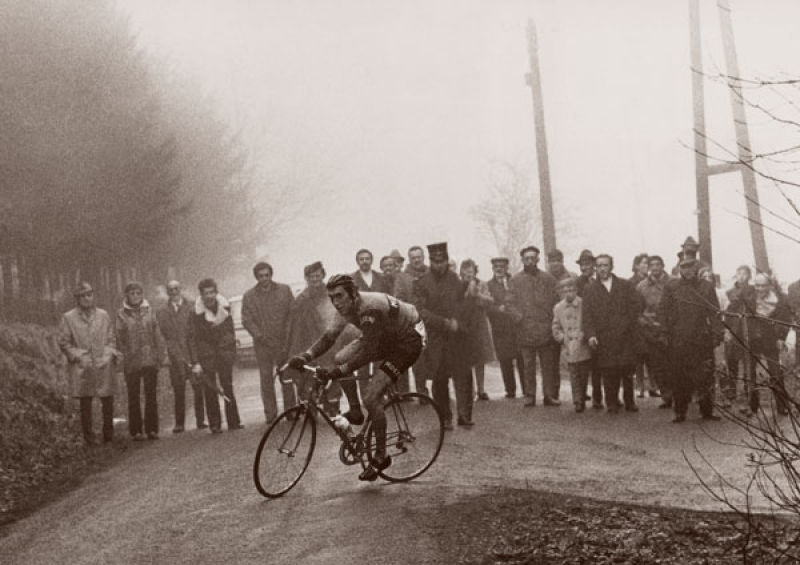The Side of the Road, Episode 1: La Gleize
Manage episode 166458202 series 1262014

Eddy Merckx summits The Stockeu in 1971. Photo courtesy of classicvintagecycling
https://podcal.files.wordpress.com/2016/11/sideoftheroad_episode1_revision_mixdown.wav
The sport of cycling has several huge one-day races that it regards as monuments. If you go watch one, here’s what you’ll see: thousands of people, covering the roads and any climb. They stretch their necks to peer over each other and wait for the racers to approach, and then suddenly, they part like the Red Sea as the riders speed towards them up the climbs. The racer’s mouths are agape, heaving air, battling each other. The fans scream for their favorite riders, sometimes trying to run alongside them, urging them on.
Among the monuments, the oldest is Liege-Bastogne-Liege, or “La Doyenne”, which means, “The Old Lady” or “The Old One”. The race is located in Southern Belgium, a region called Wallonia. But the race’s most exciting terrain lies within the Ardennes forest, where unpredictable weather and steep climbs await. The roughly 120-mile race had humble beginnings as an amateur race, and was organized as a publicity stunt for the newspaper, L’Expresse. It took years for the race to catch fire, and only after a few foreign riders won the race, did it get added to the professional cycling calendar. From then on, its reputation grew, and the length of the race was extended to 160 miles. According to a 2014 poll of all of the world’s top-tier professional cyclists, Liege-Bastogne-Liege is not only the hardest race of the year, but the most widely loved.
The main reason that the race became so popular is, in part, due to the exploits of Eddy Merckx, the greatest cyclist of all time. Images of him riding alone over the misty hilltops of the Ardennes Forest captured the public’s imagination in 1969. By the end of his career, Merckx had won the race a record five times, which has not been challenged ever since. According to a 2014 poll of top tier professional cyclists, Liege-Bastogne-Liege is their favorite race. Nowhere else do they go so deep, for one day, just to stay in contention. Laurens Ten Dam, a Dutch pro who is one of the most experienced riders still racing, remembers one year, when he finished in the front group, in 34th, “I was so sick after the race. You are too tired to eat, the only thing I could do is lay there. Hours later, our team masseur gave me some chips, and I started to eat slowly, and came back to life. Pretty soon I had eaten two big bags.”
The Ardennes Forest is not just a place where the best cyclists in the world do battle every year, it is also where the Battle of the Bulge took place. In 1944, during World War II, the Americans and British had forced the Germans to retreat back into their country. A stalemate briefly settled, and news reports showed that the Americans were strengthening their supply lines to their troops, to ready for an all-out assault towards Berlin. Hitler used this brief respite to raise an army outfitted with enormous Panzer tanks. His idea was to use the fighting force, largely comprised of the Nazi fanatic soldiers, the SS, to break through the Allied lines and cut off their supply lines by taking the crucial port city of Antwerp. Hitler’s hope was to force a negotiated peace with the Americans and British if he could push them back. The plan necessitated that Germany attack through the most lightly defended portion of the Allied frontlines, in order to capitalize on Hitler’s “blitzkrieg”, or lightning attack, strategy. The thinly defended area of his choosing happened to be the Ardennes forest.
Liege-Bastogne-Liege and the Battle of the Bulge occupy the same territory, and their histories comingle through the people who live in the area and the stories they tell. Gerard Gregoire is one survivor who lives nearby the race course and listens the coverage on the radio every year. He also has memories of Eddy Merckx early exploits. For people like Gerard Gregoire, Liege-Bastogne-Liege is like a perennial thread, woven across his life, linking the bad times and the good. It’s a memorial of sorts, an exciting spectacle on the one hand, and a reminder of the Ardennes’ troubled past, on the other. Alongside the course, there are churches, bakeries, pastures, forests, and castles, all containing deep meaning for different people, and their stories unlock the hidden meaning in everything that surrounds the race.
10 episodes




